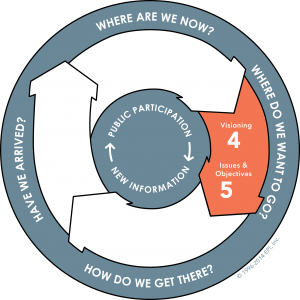We were approached by the Council for the Advancement of Native Development Officers (Cando) to write a quarterly article on the strategic planning process for their newsletter – ‘N-Side’. Cando is a great organization that provides support and capacity building for Economic Development Officers in First Nations communities.
Cando has now published 4 of the 5 articles in the series, and we thought we’d republish the articles here on our blog as they come out (though, admittedly, they are a bit long for a blog post!). The articles follow the 10 step strategic planning process that we use in all our work, and each article will highlight a few of the planning steps. We are happy to share this information and hope that it is useful for your planning processes. If you are going to use it in toolkits, guides, or other materials please give us credit.
The following article was published in the July 2013 issue of Cando N-Side News

By William Trousdale and Colleen Hamilton, EcoPlan International

The planning process we are describing follows a ten-step process, structured around four Big Questions (see image). In this article, we’ll be working through the second Big Question –WHERE DO WE WANT TO GO? – which will help you to figure out your vision for economic development in the community, and set the stage for identifying the objectives to move towards that vision.
Create your Economic Vision Statement
A vision is a statement about the desired economic future of your community. The economic vision statement should be grounded in the realities of your local community (money, skills, geography etc.) and should build off your community’s broader vision statement if one exists.
There are many ways to generate a vision statement. Here is one useful method:
- Set a time frame for the vision (often 5 or 10 years is a good start)
- Conduct a review of existing information on your economy (work done in Step 3 of this planning process would be useful here)
- Work with your stakeholder group and ask the following questions:
- What is your ideal future for the area?
- What are the most important economic aspects of this desired future (e.g., types of jobs, income levels, poverty levels, types of companies)
- What is different about your vision than what you see today?
- Collect and group similar ideas
- Have the facilitator or someone else ‘wordsmith’ these notes into a few options for vision statements, then run them by the stakeholder group to make some small changes and get agreement
A note on visioning
Creating a vision can be a great way to bring different members of your community together, discover common goals and get everyone ‘on the same page’. However, don’t take too much of your time, money or participants’ energy on this step – you want save some of that for later planning steps. Remember, you can always come back and refine your vision later.
Issues and Objectives
Objectives are the building blocks of an economic development strategy that moves you towards your vision statement.
To come up with objectives, first work with your stakeholder group to create a comprehensive list of ‘issues’ that the community is facing. Issues can be positive or negative, for example, high unemployment, or new forestry operations on your territory.
Next, turn those issues into objectives by pairing each issue with a verb or phrase that explains the direction that you want that issue to go in. So, using the examples above, your objectives could be to reduce unemployment, and maximize the economic opportunities from forestry operations on your territory.
Now you can use these objectives to evaluate the action ideas you will come up with in subsequent planning steps – would this action reduce unemployment? Would it help maximize opportunities from forestry operations on your territory?
Conclusion
Now that we know where we want to go, we need to figure out how best to get there. In the next article we’ll get creative and start talking about action ideas – how to come up with realistic action ideas and how to choose the best ones to implement.
William Trousdale is the lead author of: “Promoting Local Economic Development through Strategic Planning” by UN-HABITAT and EcoPlan International (contact us for a copy). He can be reached at william@ecoplan.ca. Colleen Hamilton is a planning analyst at EcoPlan. She can be reached at colleen@ecoplan.ca
